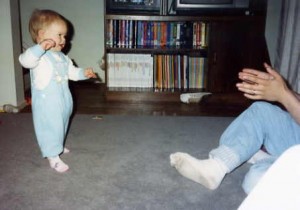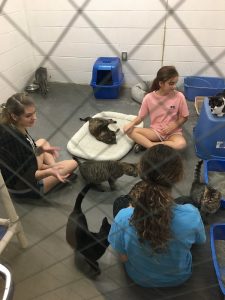How many people have made a mistake? Raise your hand.
How many people have succeeded? Raise your hand.
How many people have struggled? Raise your hand.
How many people have overcome something? Raise your hand.
How many people have strengths? Raise your hand.
How many people have weaknesses? Raise your hand.
How many people have felt sadness? Raise your hand.
How many people have felt joy? Raise your hand.
This is called living life! No one will avoid any of these questions in the affirmative. Including your children. At this time of year, I consistently hear homeschooling parents preparing for the new school year, and one of the  things I hear in their messages is anxiety. They want to do it right. They don’t want to mess up their child. They want to show people how smart their child is. They want to prove to people they are capable of homeschooling their child. Fear of failure for themselves. Fear of failure for their child. So, they look for a “formula for success.” The school scope and sequence is usually what everyone looks to as the measuring stick to success.
things I hear in their messages is anxiety. They want to do it right. They don’t want to mess up their child. They want to show people how smart their child is. They want to prove to people they are capable of homeschooling their child. Fear of failure for themselves. Fear of failure for their child. So, they look for a “formula for success.” The school scope and sequence is usually what everyone looks to as the measuring stick to success.
Here’s the problem with that. Do you recognize these terms? No Child Left Behind. Race to the Top. New Math. Phonics. Whole Reading. Open Classrooms. Flipped Classrooms. Common Core. The list can go on. There are always new initiatives to “improve” schools. That means tomorrow’s new initiative will replace today’s. So, why are we convinced that following an ever changing scope and sequence target is the way to go? The programs in school initiatives change because bureaucrats realize that the results are not acceptable.
So, what are we supposed to do? Another common adage we may lament is, “I wish each child came with an instruction manual.” Well, they do! It’s just that the owner’s manual is inside each child, and it’s our privilege to create a space to allow that to unfold itself. And all of those things we raised our hands to in the beginning of this post; it comes with the territory of the unfolding. Our job? To model imperfection well. Let’s discuss some common fallacies:
Fallacy No. 1: Early Learning Equals Smarter
Our culture pushes Head Start programs, academic preschools, and Baby Einstein products. Yet, we keep falling further and further “behind” the global comparisons. Why? Because absolutely no brain research supports “early is better.” In fact, all the studies point to later, and top world contenders in academics, like Finland, prove it with an academic start date of 7 years old. We continue to ignore all the evidence contrary to learning earlier means more intelligence.
 I had an interesting opportunity to learn this from my oldest child and my fourth child. My oldest son has an IQ in the gifted range. He began to read at 9 years old. He jumped to adult novels by 10. My fourth son has an IQ in the mentally retarded range. He began to read at 4 years old. He capped at about a 3rd grade reading level. Acquisition of an academic skill, such as reading, has nothing to do with intelligence. It has to do with brain processing preferences and personal strengths and weaknesses.
I had an interesting opportunity to learn this from my oldest child and my fourth child. My oldest son has an IQ in the gifted range. He began to read at 9 years old. He jumped to adult novels by 10. My fourth son has an IQ in the mentally retarded range. He began to read at 4 years old. He capped at about a 3rd grade reading level. Acquisition of an academic skill, such as reading, has nothing to do with intelligence. It has to do with brain processing preferences and personal strengths and weaknesses.
Shifting Perspective: The brain is developing throughout childhood. In the 5 to 7 year range, the brain is functioning primarily in its preferred processing strengths. A left-brained dominant child is focused on words and sequencing, the strengths of that side of the brain. A right-brained dominant child is focused on pictures and imagination, the strengths of that side of the brain. These are different focuses, thus, there will be different products unveiled from the different brain processing preferences. And there are variables within each of those as well.
What did I do? I gave the space and time for my children to reveal their strengths and preferred processing to me by allowing them to lead out through their play and their interests. I would bring in lots of play offerings, lots of interest offerings, and lots of community trip offerings. And I developed my ability to observe and notice learning preferences within those activities from which my children engaged. I fed in more of the same things into their lives when I saw a spark. I tried not to steer or lead or capitalize on, but rather add to, expand on, or bring out more things they could feast on.
What are we pressured to do instead? We press each child down the exact same path toward the exact same outcomes. In preschool, it’s all about identification of the alphabet and numbers and other pre-word skills. In kindergarten and first grade, it’s about reading, writing, spelling, and arithmetic. These may be strengths for some learners, but not for others. Yet, we are convinced by others that this path equals future success and an indication of intelligence. It just isn’t true. Two studies off the top of my head alone negate this. Play in the early years is now being revealed as highly important to future success. A positive relationship with reading occurs more often with later reading instruction rather than earlier. I talk about this subject extensively in Chapter Four in my book, The Right Side of Normal.
Fallacy No. 2: We Can’t Teach our Own
I was talking to a young family friend about her oldest son’s upcoming preschool year when she confessed: “I was going to teach him all his letters and numbers before he went to preschool so they would all say how smart he is. He was having nothing to do with it. He doesn’t learn from me well. I’ll leave it to preschool. It’s better that way.” This attitude reveals the previous fallacy and adds a new one: our children can’t learn from us. Did the child not learn because the parent wasn’t qualified? Or was it because he wasn’t ready to learn?
Shifting Perspective: I don’t have to know all the teaching strategies to keep a classroom full of children’s attention. I don’t have to have the perfect  curriculum. Our children have been learning in our home since they were born! They learned to walk, talk, play, have manners, climb, jump, colors, shapes, count, and so much more in our homes. You didn’t have an instruction manual or a curriculum to do any of that. All you have to focus on is your child right in front of you. I promise you that they will reveal to you what they love to do, how they learn, and what gets them excited if you watch and observe.
curriculum. Our children have been learning in our home since they were born! They learned to walk, talk, play, have manners, climb, jump, colors, shapes, count, and so much more in our homes. You didn’t have an instruction manual or a curriculum to do any of that. All you have to focus on is your child right in front of you. I promise you that they will reveal to you what they love to do, how they learn, and what gets them excited if you watch and observe.
It’s not rocket science. I learned something important when I put two of my children with autism into a university’s speech-language program where master’s students were assigned and a Ph.D. instructor oversaw. I had already learned a lot about how these two children learned, but I wanted them to have experiences with other people. I chose this because of the one-way mirror from which I could observe. Each semester, goals were created. Each semester I offered to share what I knew on how my children learned. Each semester it was declined by the master’s student as they felt intimidated under the watchful eye of the doctorate supervisor. Each semester, they failed to progress in speech (but that wasn’t my goal). One semester, a brave master’s student chose to take me up on my offer. There was immediate progress. I was watching through the one-way mirror when the doctorate supervisor showed up behind me. She began to speak to me about all the years of training she had, how she was taught a certain way, and thus, that was how she taught the new students. It was her way of basically saying she was stuck in her expertness. I loved a saying I found that can be applied to homeschooling as well:
I go where no expert dares to tread.
What did I do? The cost is as simple as feeding that spark. Get resources. Answer questions. Give them time. Help them have the confidence that they can learn on their own. Each child of mine had a bookshelf in their bedroom space. I would put various living books or kits in there for them to discover or glean from when they were bored in their room, especially before going to bed. Having raised a large family, there was a time when everyone was asked to go to their own rooms to chill before bed. This is  when my children might peruse their bookshelves and start picking up on things.
when my children might peruse their bookshelves and start picking up on things.
Remember how your young child would choose to play with the box a present came inside of instead of the actual toy? Yeah, this is the version of that. Did you know that most of my high schoolers didn’t take biology? Or write a research paper? Or have a GPA? Yet, they were 4.0 college students who earned academic scholarships. How is that? Readiness for college is more about an overall raising of intelligence versus having a specific subject mastered. That was accomplished through things like:
- Personal projects were valued and encouraged as number one.
- Learning from a variety of resources such as living books, instructional television shows like The History Channel or Myth Busters or the Outdoor Channel, or from countless You Tube videos.
- Filling in gaps with well-matched learning resources that focused on a specific skill needed.
They knew how to learn. They loved to learn. They had a voice. They had intrinsic motivation. They had balance. They had a myriad of interests.
What are we pressured to do instead? Buy curriculum! I’m not saying that it is a bad thing. I am saying you are putting the cart before the horse. There are no educational emergencies! You have time. Yes, even with a middle schooler. Or a high schooler. There is no perfect education. There are tools. There is engagement. Encourage personal projects. Consider some living books. Encourage your young people to have a voice, an opinion, an argument, a thought. For example, if they are in middle or high school, buy A Young People’s History of the United States, by Howard Zinn, for history and let them share their opinions about what they read. If they are in elementary school, watch what they become interested in and give them more options in that area.
As we know very well, life as an adult has its ups and downs. Life as a child has its ups and downs. It comes whether we want it to or not. Life is all about imperfection. Yet, our instinct is to try to do everything perfectly. The gift we can give our children is how to do imperfect graciously. When we choose to educate at home, we get to model how we deal with  imperfection every day. Do we do so with grace or frustration? Do we enjoy learning fully in the moment allowing for all the rabbit trails, or do we keep our head down focused on getting through the schedule for the day? Does getting all the boxes checked mean we succeeded? Adding in other important traits beyond academics is important such as volunteering, kindness, connection, life skills, and emotional intelligence.
imperfection every day. Do we do so with grace or frustration? Do we enjoy learning fully in the moment allowing for all the rabbit trails, or do we keep our head down focused on getting through the schedule for the day? Does getting all the boxes checked mean we succeeded? Adding in other important traits beyond academics is important such as volunteering, kindness, connection, life skills, and emotional intelligence.
I learned a lesson from a brief encounter. There is something called hyperlexia. It means someone at a very young age, or a person with a lower IQ, can decode any word they come across and read at a very high level. It can be a common occurrence with autism. A parent of a five year old hyperlexic child who could read college texts asked me, “Does it matter that he doesn’t understand what he’s reading?” You tell me. Does it matter that our children get through all the curriculum even if they only retain a third of it? You tell me. Does it matter if you checked all your boxes for the day, but it took yelling at everyone to accomplish it? You tell me. Learning can be a joyful experience if you take perfect out of it.
What does homeschooling imperfectly look like?
- Making mistakes is a valuable learning opportunity.
- Using a variety of resources can open your eyes to vantage points you hadn’t considered.
- Everyone has sad days, off days, edgy days or bleh days. Having a still day or a fun day or a connecting day or a mental health day is learning, too.
- Spending hours or days or weeks on one idea often results in deep, meaningful, and multi-faceted knowledge and skill gains.
- Products are not always the result of learning; process counts: thinking, discussing, reading, pondering, questioning.
- Puzzling through how to do something helps you never forget when you figure it out.
- Some days or weeks may be focused on developing emotional intelligence and family relationships. That’s important, too.
- Feeding a curiosity can lead to exposures to ideas or interests you would not have ever thought to connect together.
- Weakness is a way to challenge you on how to use your strengths to overcome it, work around it, or go through it.
- Having space for boredom can be a catalyst for inspiration.
- Correcting ones own work and figuring out the errors for yourself is part of the learning process. Working backward from the solution counts.
- A month may only consist of one highlight with learning, but it is deep and wide and lasts a lifetime!
- Deciding on your own project challenges a person to be creative and innovative.
Homeschooling can open the door for an entirely new learning experience. Embrace homeschooling imperfectly! It may just end up a perfect fit.





